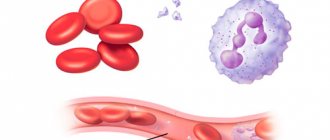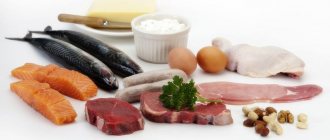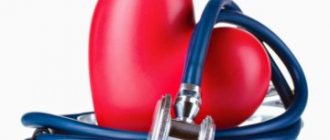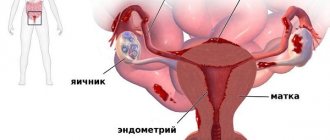Acceptable rate
Triglycerides are components from which the body obtains its main energy. That is why it will not be possible to do without them.
But the diet of a modern person is designed in such a way that he receives much more fat and carbohydrates than he needs. This is also complemented by a trend towards a widespread decline in physical activity.
What is the result? Approximately 60% of adults aged 25 years and older have elevated blood triglyceride levels. Accordingly, already at this age there is an excess load on the cardiovascular system, but the consequences make themselves felt after 40–50 years.
What triglyceride level is considered normal? The following indicators (in mmol/l) are relatively “safe”:
- for children under 15 years of age: for boys 0.36 – 1.41, for girls 0.42 – 1.48;
- from 15 to 25 years: for boys 0.5 – 2.17, for girls 0.41 – 1.48;
- from 25 to 60 years: for men 0.65 – 3.23, for women 0.62 – 2.96;
- after 60 years: for men 0.65 – 3.29, for women 0.68 – 2.96.
General Diet Principles and Goals
The goal of a diet for high triglycerides is:
- reducing the intake of neutral fats, primarily saturated and heavy fatty acids, into the body;
- increasing the fraction of unsaturated fats or vegetable and fish oils;
- intake of large amounts of fiber;
- switching energy needs to the use of easily digestible carbohydrates, which eliminate the formation of large amounts of fat reserves.
As a result, the ultimate goal will be to reduce the concentration of triglycerides to an acceptable level, and for this you need to use specific food processing methods and know some tricks:
- meat products should be easily digestible, low-fat, they should be consumed boiled, less often baked, fried foods should be avoided;
- consume dairy products without cream, low-fat sour cream, fresh and low-fat cheeses;
- It is advisable to exclude butter and fatty cheese from the diet and limit yourself to vegetable oils.
A patient who has decided to eat properly should remember that if he reduces the intake of saturated fatty acids, this will also lead to a decrease in the fraction of bad cholesterol, which will also cause a decrease in the progression of atherosclerosis.
In dietetics, there is a rule that it is better to limit bad foods by half than to double the consumption of healthy ones. This means that if the patient limits by half the intake of saturated refractory fats, such as animal butter and lard, it will be more beneficial than if he leaves these products in his diet, but, “as compensation,” doubles the intake of healthy vegetable oils.
Let's look at three food groups that are standard in any diet. These are foods that need to be excluded completely, foods that should be significantly limited - once or twice a week, and the third is a predominantly recommended group of foods. Let's start with the prohibited ones.
Why might their level be increased?
Short-term deviations from the norm of approximately 0.2 - 0.3 mmol/l are not something critical. This most often occurs after a heavy snack with a lot of fatty foods.
But within 1–2 hours, the body independently normalizes the balance of tringlycerides in the blood, activating the processes of their breakdown into energy.
Why do triglycerides increase? There can be many reasons, but the most common among them are:
- non-compliance with a healthy diet (abuse of fatty, sweet, and alcohol);
- problems with the functioning of the endocrine system (imbalance of hormones responsible for regulating metabolism);
- taking certain medications (directly affecting the functioning of the hormonal system).
Elevated triglyceride levels can also occur during pregnancy. This is not a deviation, it is not dangerous, but it is advisable to periodically consult a doctor on this matter to monitor the condition of the pregnant woman herself and her unborn child.
What to reduce?
If triglycerides are elevated, the diet includes limited consumption of the following foods:
- various pasta, rice, and especially polished. Unpolished varieties, rice mixtures, dev-jeera are quite suitable for pilaf;
- limit even not too fatty varieties of cheese, for example Maasdam;
- limit seafood - squid, shrimp, mussels;
- fatty varieties of poultry meat and the most refractory: these are ducks and geese, old and fat-tailed lamb;
- meat dishes with visible fat. We are talking about sausages, bacon, meat and liver pies, salami, liver and poultry pates;
- For hyperlipidemia, it is advisable to consume no more than two or three eggs per week;
- halva, Brazil nuts and cashews, pistachios, sponge cake and shortbread dough, it can be cooked in an unknown fat;
- high-calorie alcoholic drinks, beer, coffee with large amounts of milk and cocoa with milk, salad dressings are limited even with a low fat concentration, such as sour cream and butter sauces.
Let's move on to a variety of healthy foods without restrictions.
Folk remedies - Top 4
In folk medicine there are at least 10 effective means for normalizing the balance of triglycerides in the blood. The most effective among them are:
Bean pod decoction
It will help speed up metabolism and also saturate the body with minerals, potassium, and zinc. Prepare as follows:
- soak 100 grams of dried bean pods overnight (only the boxes, without the bean seeds);
- in the morning - drain the water, add new water and bring to a boil over low heat (1 liter of water per 100 grams of pods);
- after 20 minutes, remove from heat and let cool to room temperature;
- strain through 2 – 3 layers of gauze.
Take 50 milliliters 3 times a day 30 minutes after meals. The course of treatment is 2 months. This remedy will also help you quickly get rid of 2 - 3 extra pounds.
A mixture of garlic, lemon and horseradish root
This is an extremely effective means for cleaning blood vessels. This is especially noticeable in the rapidly decreasing levels of low-density cholesterol. Prepare as follows:
- mix 1 head of garlic, 25 grams of grated horseradish root, 2 medium lemons (including peel);
- Grind everything thoroughly using a meat grinder, blender or food processor;
- leave overnight in a cool, dark place.
Take 2 times a day, 10 grams (1 teaspoon) with meals. The same remedy will help comprehensively strengthen the immune system of a weakened body.
Infusion of crushed flax seeds
To prepare an infusion from flax seeds, fresh flax seeds are taken. They are first passed through a meat grinder; it is better to grind them with a blender.
About 30 grams of the resulting slurry is poured overnight with a glass of boiling water. In the morning - squeeze and drink on an empty stomach (20 - 30 minutes before the planned meal).
Drink once a day, course – up to 30 days, then a break of 2 weeks.
Linden flower tea
A tasty, simple and effective remedy for quickly lowering the concentration of triglycerides in the blood. Tea is prepared from flowers collected at the very beginning of the tree's flowering.
Dry them in a dark place with good ventilation. To prepare tea you will need only 0.5 - 1 teaspoon of dried flowers (per 1 glass of the finished drink).
You can drink up to 2 times a day, add honey and sugar to taste. This remedy can be given even to small children (from 3 years old, according to doctors’ recommendations).
What are the side effects of fibrates?
The most common side effects are nausea, stomach/intestinal upset, and sometimes diarrhea. Also, medications can negatively affect the liver. Liver problems are usually mild and disappear quickly, but sometimes they can be serious, requiring immediate cessation of use of the drug.
When taken over a long period of time (over several years), fibrates can cause the formation of gallstones.
Fibrates may increase the effect of drugs such as Warfarin/Coumadin (anti-clotting drugs). Thus, their dosage should be adjusted to avoid negative consequences (bleeding from the nose or gums, prolonged menstrual flow and other options associated with “depletion” of blood).
A very rare but most dangerous side effect is rhabdomyolysis (a critical condition in which muscle cells are destroyed). The muscles most affected by this disease are the back and calves, although some patients do not feel any symptoms.
Rhabdomyolysis can lead to kidney/liver failure and even death. The risks of this serious complication are higher for fibrates that are used together with other cholesterol-lowering medications. But one of them, Fenofibrate (as practice has shown), is as safe as possible when interacting with statins. That is why it is considered the preferred fibrate for combination therapy.
Patients should immediately report the following symptoms of rhabdomyolysis to their doctors:
- muscle cramps, pain, swelling, or weakness;
- fever;
- dark urine;
- nausea and/or vomiting;
- an unexplained feeling of malaise/weakness or discomfort in the body.
In addition, some studies suggest that taking fibrates, especially Clofibrate, may increase the risk of developing cancer, pancreatitis (inflammation of the pancreas), gallstones, or cause problems after gallbladder surgery. It is recommended that you discuss the potential risks and benefits of fibrates with your doctors.
Medication methods
If a patient is diagnosed with high levels of triglycerides, then doctors, first of all, recommend changing lifestyle, as well as optimizing the diet. But if these recommendations do not give the desired effect or the patient for some reason cannot comply with them, then the following are prescribed:
Physiotherapy
These are the same physical activities, but a set of exercises is compiled individually for the patient (to reduce the load on the cardiovascular system).
The diet also taken into account is also taken into account. As a rule, the first classes are conducted with a specialist, then the patient himself controls the implementation of physical therapy.
Nicotinic acid preparations
They will help reduce the level of triglycerides and cholesterol, since such drugs partially block the process of lipolysis - the release of fatty molecules from cells into the blood.
However, long-term use of such drugs is not recommended - this can cause obesity.
Fibrates
Such drugs “interfere” with the liver and inhibit the synthesis of fats in the body. The most common pharmacological agents in this category are Atromid, Gevilan.
Their long-term use is not recommended, as this can provoke the formation of stones in the liver.
Drugs affecting the secretion of bile acid and enzymes
With their help, the functioning of the gastrointestinal tract is corrected to achieve a reduction in the amount of fat obtained from food. The most common drug in this category is Ranitidine, used in the treatment of stomach or duodenal ulcers. Admission is carried out only in short courses.
All of the above drugs can be used only after a comprehensive diagnosis, when the exact cause of elevated triglycerides has been established, and other measures have been taken to normalize their levels. Consultation with a doctor is required.
In what form are fats found in the blood?
Blood is primarily plasma, a water-based liquid. Fat is insoluble in water, and the fat in the soup illustrates this perfectly. Fatty bits cannot float in the blood; in this case, they will clog the blood vessels, and there is even a known pathological process called fat embolism. In what form are they found in blood plasma? It is clear that if we are talking about triglycerides, or neutral fats stored in adipose tissue, then there is no question: they are a long-term supply of energy, primarily for muscles. But before they get into the adipose tissue, they need to be somehow transported into it.
Since a lot of energy is stored in lipids, the body expends quite a lot of its energy to obtain pure and high-quality fat “in reserve.” First of all, there are no enzymes in human saliva that break down fats. Therefore, fatty foods do not change in the oral cavity. But already in the gastric juice there is a certain amount of gastric lipase, but its role is also small. There is little of it in the stomach, and the acidity of gastric juice is so high that fats are practically not digested. Therefore, in adults, the most important factor that facilitates the breakdown of fats is bile and bile salts. They emulsify fats and then the fats are broken down by pancreatic lipase. As a result, fats are broken down into triatomic alcohol glycerol and residues of higher fatty acids.
After this, the broken down fats are again synthesized in the cells of the intestinal wall into triglycerides; this reaction is catalyzed by a special enzyme, which requires energy. After foreign fats have been broken down and their own, human fats have been formed, they need to be transported. This is why chylomicrons and lipoproteins of varying densities are needed, when fats in the blood are protected from the outside by protein molecules. On the blood side, these proteins are hydrophilic, and on the fat side, that is, their inner surface is lipophilic, and this prevents contact between two foreign environments.
1 or 2 hours after eating a fatty meal, an increase in the concentration of triglycerides in the blood occurs, or so-called nutritional hyperlipidemia. This is a completely normal physiological phenomenon, which means that you need to donate blood for triglycerides on an empty stomach, and under no circumstances should you go to the laboratory after eating a fatty meal.











